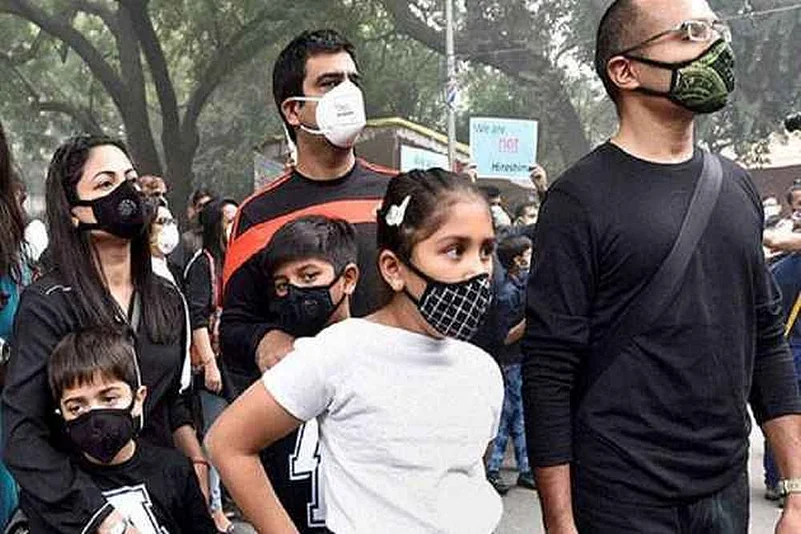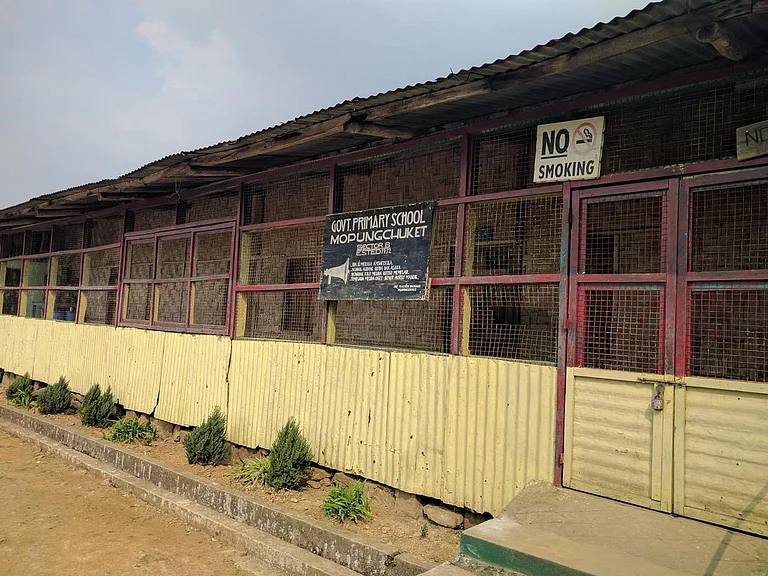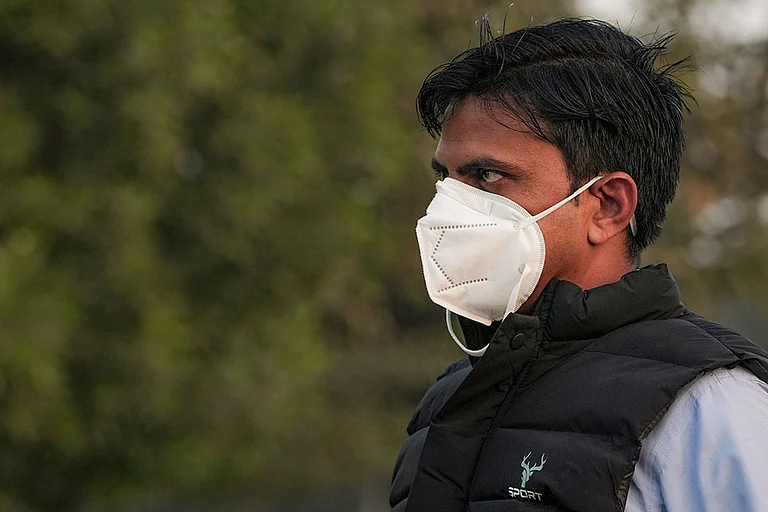Delhi is experiencing another season of smothering air quality with AQI approaching 500 on November 18, 2024. Outlook has dealt with the issue of pollution in Delhi in depth and we are republishing some of the articles that provide insight into its cause and effects. This article was originally published in Outlook issue 'Where Stars Don't Shine' dated 20 December, 2021
Three years ago, when some of us concerned citizens organised a townhall titled ‘Country with a Mask’ at the Constitution Club in Delhi, it was in the hope that our efforts might rouse the authorities from their perennial slumber and take action to tackle the ever-growing menace. But here we are, at the fag end of 2021, living the same old life, breathing even more toxic air. From two good air days in 2019 and five in 2020 amid the Covid lockdown, we managed only one this year. The national capital region’s air quality has stayed in the ‘very poor’ category for months now, often touching the maximum that the monitoring gauges can read.
On paper, a lot has happened in the last year, from dismantling of the EPCA to constitution of another committee with a different name, ‘Commission for Air Quality Management in National Capital Region and Adjoining Areas’ (CAQM), first through an ordinance and then by way of an Act of Parliament. The commission recently came out with the idea of having ‘flying squads’, 40 in number, to check violation of norms in Delhi and adjoining areas. That’s a total of 6.8-lakh square kilometres spread across Haryana, Punjab, Rajasthan and Uttar Pradesh, besides Delhi.
While the government, experts, courts and media all speak of tackling air pollution in broad terms and through screaming headlines, mothers like me are getting more anxious by the minute, knowing that in the city we call home, every third child has impaired lungs. Shutting down schools as a knee-jerk reaction is considered one of the solutions, but there is no clarity on what exactly needs to be done urgently on the ground at the micro level. We must accept that breathing poisonous air has now been normalised with the typical Indian attitude of chalta hai.
ALSO READ: Our Starless Skies: Even Stars Are Unable To Break Layers Of Smog
When an ordinary citizen like myself complains to the Central Pollution Control Board or the CAQM now, all I will perhaps receive is a complaint number. That too, if I’m lucky. Does it matter to the Commission that despite Delhi topping the list for the most-polluted capitals in the world, the Delhi Pollution Control Committee (DPCC) is grossly understaffed. The DPCC has 192 vacant posts as of November 2021, which need to be filled up on urgent basis and equipped with necessary infrastructure, including vehicles, wireless communications, and infrared cameras for detecting release of volatile organic compounds from industries in order to effectively enforce the law on the ground. For example, in order to enforce the Construction and Demolition Waste Management Rules 2016, with zero tolerance towards violators, the government needs boots on the ground not apps or advertisements.
Similarly, if I report an incident of illegal tree cutting, there is unlikely to be any immediate reaction, and guess why? Because, the Delhi forest department is also in a similar state—understaffed and ill-equipped, due to which green cover in Delhi is under constant threat. In 2015, the National Green Tribunal had directed the Delhi chief secretary to fill up the vacant posts in the forest department by December 2015, but till date it has not been complied with.
ALSO READ: Efforts To Clean Up Delhi’s Air Must Continue Through The Year Not Just During Winter
As per the India State of Forest Report 2019, forest cover in Delhi is only 13.18 per cent and tree cover is 8.73 per cent of the total geographical area. This means that only 21.91 per cent of Delhi’s geographical is under green cover against the national mandate of 33 per cent. Numbers don’t lie and here is the stark reality: One tree is cut ever hour in Delhi and this year alone, the Delhi government allowed felling of 18,879 trees. And this number is only till October 7. This does not include the odd tree that vanishes every few hours due to mindless trenching work by the PWD or construction of four-storied houses in municipal areas, and certainly does not include illegal felling which goes unnoticed. An environmental lawyer tells us citizens that the air in Delhi is so saturated that it doesn’t have the strength to carry the heavy burden of sustaining life. Are we accepting this for ourselves and our children? Why didn’t the commission order a moratorium on felling of trees in Delhi-NCR even in this state of national emergency? Perhaps, we are so glued to the idea of smog towers that trees mean very little to us.
The enforcement wing of the Delhi transport department is responsible for checking polluting vehicles, overloaded vehicles etc., and need to be equipped with a wireless system having interface with police. Its cadre strength also needs to be increased to have more teams on the ground to check vehicles. As per a court commissioner’s report submitted to the NGT, at one border point alone, Singhu, over 4,800 trucks—an average of 16 trucks per minute—pass through during a five-hour period from midnight, with only one enforcement team of six officials present. Additional companies of central armed police force (CAPF) on all border checkpoints are needed today, and not next year, to assist the enforcement wing to effectively stop polluting vehicles from entering Delhi.
ALSO READ: Right To Breathe | Air Pollution: When Will Our Politicians Wake Up?
It takes no rocket science to understand that we need a super-efficient public transport system which has to be convenient and the cheapest possible. But year after year there are only excuses. Instead of taking crores of rupees as loan from foreign funding agencies for white elephants like the metro, spending a fraction of that amount on strengthening the bus system would give the city the best public transport it needs. Even in this time of grave air crisis, we are stuck in traffic jams; and idling vehicles only adding more poison to the already foul air. A basic action would be better monitoring of traffic signals and a complete no to diversions and roadblocks. Footpaths have no place for pedestrians as they have been overrun by two-wheelers and street vendors. What stops the authorities from clearing the mess urgently? Also, from failing to implement the ban on crackers to making a mess of the Solid Waste Management Rules 2016, the authorities have a lot to answer.
We mothers are not willing to take these ‘fictional’ stories with new names. Not anymore. Representing thousands of Warrior Moms at COP26, Glasgow, this was the message for the global leaders from us: Act4OurKids. And this is the message that continues back home. We cannot remain helpless parents as our children grow up with the real possibility of living 10 years less because the authorities didn’t do their job. It’s time to wake up. All of us!
Bhavreen tweets at @BhavreenMK
(Views expressed are personal)
ALSO READ
High Density Population Adds To The Woes Of Pollution In Delhi Slums During Winter
Show, Don’t Tell: With 'Lungs Billboard', See How Filthy Is The Air You Breathe
'Tareekh Pe Tareekh': It's Time To Act Against Air Pollution, Don't Postpone Things
Air Pollution In India: The Time To Act Was Yesterday
Welcome To Mahul, The Living Hell On Mumbai’s Eastern Outskirts
Smog Screen: Bihar's Staggering Pollution Levels Are Often Worse Than Delhi’s
Is India’s Pollution Data Hiding Behind The Poor?
For These Young Minds, Pollution Is A Bigger Menace Than Others
Solutions To Air Pollution: It's Time To Be Aimers, Not Blamers
Children From Poor Backgrounds Are Worst Sufferers Of Pollution
Menace Of Pollution: Like Cities, Rural India Is Equally Gasping For Clean Air
Bhavreen Kandhari is an environmentalist and member of warrior moms, a campaign group fighting to reclaim the blue skies for their children





















